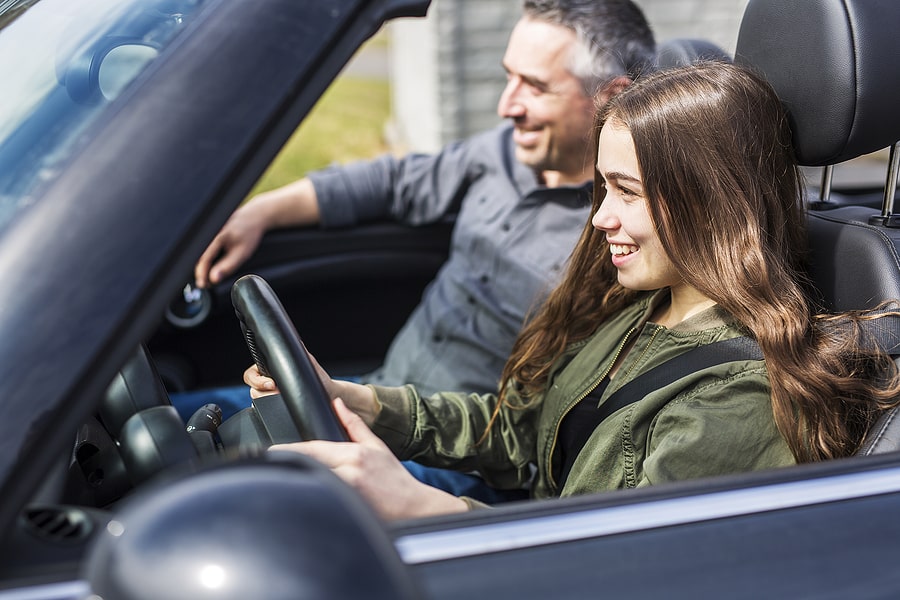The #1 cause of death for American teens is car accidents. October’s National Teen Driver Safety Week was established by Congress in 2007 as a way to raise awareness and seek solutions for a tragically persistent problem.
Did you know? Teen drivers between the ages of 16 and 19 are four times more likely to be involved in a fatal car accident than adult drivers. 16-year-olds, specifically, have the highest crash rates of any driver demographic. Risks increase with each additional passenger added to the vehicle.
Thousands of teens lose their lives in motor vehicle crashes every year, leaving behind grieving parents. How can you and your child avoid becoming one of these statistics?
Read on below to learn more about the causes of teen car accidents and what can be done to prevent them.
If you or your teen driver has been involved in an accident, we can help you explore options for compensation. No matter what kind of auto accident you and your family are coping with, we’re here for you. We’ve represented victims in numerous kinds of cases, including bicycle accidents, motorcycle crashes, pedestrian accidents, Uber and Lyft accidents, and more.
Contact us now and get connected to a car accident attorney!
Teen Driver Accident Statistics
Let’s begin with some good news, shall we?
Over the last few decades, teen car accident fatalities have decreased considerably – from over 9,000 in 1980 to 2,476 in 2018. (However, it should be noted that male teens have remained twice as likely to die in an accident as female teens.)
[source: Insurance Institute for Highway Safety]
In Texas, 326 teen drivers were involved in fatal crashes last year. 136 became casualties themselves. Additionally, 7% of all drunk drivers involved in fatal crashes in Texas last year were underaged. Some of the drunk drivers were as young as 14.
Neurological development comes into play, too. According to a study conducted by the Children’s Hospital of Philadelphia, teens diagnosed with ADHD are more likely to engage in risky driving behaviors. They are 62% more likely to crash within their first month of driving, and 37% more likely to crash during the first four years after getting their license, compared to their peers without ADHD. Additionally, nearly 37% of teens with ADHD were issued a traffic violation within their first year of driving, compared to 25% of teen drivers without ADHD.
Biggest Risks for Teen Drivers
It may surprise you to learn that many car accidents involving teens are not caused by reckless driving or thrill-seeking attitudes. Instead, they’re the result of simple errors associated with inexperience.
The most dangerous time period? The first 6 to 12 months after a teen receives a provisional license and starts driving on their own. After they’ve racked up their first 1,500 miles of independent driving, a teen driver’s crash risk drops drastically.
When it comes to the causes of serious car wrecks, studies point to four common-yet-critical errors made by newly-licensed teen drivers:
- Speeding:
In Texas last year, speeding contributed to over 167,604 crashes, or 30% of all reported crashes. Among male drivers ages 15 to 20 involved in fatal crashes in 2017, 31% were speeding at the time of the accident. - Distracted driving:
Drivers under the age of 20 make up the largest percentage of distracted drivers. Research has shown that texting while driving increases a teen’s risk of crashing by 23 times. Friends can be distracting, too: the chances of being in an auto accident also increase with each teen passenger added to the vehicle. - Slow responses or failure to detect a hazard:
Underdeveloped “scanning” skills mean teen drivers won’t notice a hazard in the road until it’s too late. Additionally, applying the wrong amount of pressure to the brakes in response to a hazard can result in teen drivers rear-ending someone, or getting rear-ended themselves. They may also overcorrect their mistakes, leading to erratic swerving and accidents. - Drunk Driving:
Drunk driving is a serious threat to teens. Teen drivers are less likely than adults to drink and drive, but when they do, their crash risk is substantially higher. Check out the facts: - A 2017 Youth Risk Behavior Survey revealed 16.5% of American high school students had recently ridden with a driver who had been drinking alcohol.
- Among male drivers ages 15 to 20 involved in fatal crashes in 2017, 20% had been drinking.
- Over half of all fatal auto accidents involving teens occur on the weekend. This is undoubtedly linked to partying and underaged drinking.
In summary, the teens with the highest risk of car accident involvement are male, newly-licensed, and keen to give their friends a ride.
Safety Tips for Parents of Teen Drivers
We’ve all heard of the Texas “Click It or Ticket” campaign, and you might remember seeing videos or presentations in school warning against the dangers of drunk driving or showing graphic accident scenes.
But you can’t scare your children into safety.
Focusing on positive habits and transparent communication will help you keep your teen and their friends safe. Consider the following tips:
Lead by example.
Be a good role model and eliminate any of your own bad driving habits: never text and drive while your teen is in the car, and never rush to beat that yellow light. Always buckle up and remind them to do the same, even in taxis or ride-share vehicles.
Talk it out.
Build trust with your teen. It’s important for them to know they have a safe space to discuss their driving anxieties. Encourage them to reach out for help and ask you for a ride if they or a friend are ever intoxicated, fatigued, or otherwise impaired. Emphasize the responsibility each and every driver has when it comes to following traffic laws.
Know the GDL laws.
Graduated Driver Licensing laws vary by state. In Texas, teens must stay in phase one with their “learner’s permit” for a minimum of six months. Then, once they have completed all portions of driver’s education and are between 16 and 18 years of age, they are eligible for phase two and a “provisional license.” Provisionally-licensed drivers may not have more than one passenger below the age of 21 with them, and they may not drive between the hours of midnight and 5:00AM. They are also restricted from using any wireless device, even if it is hands-free.
Set clear rules and consequences.
Whether your teen is driving a car, truck, or SUV, whether they’ve just earned their license or have had it for a few years, the rules remain the same, and you must enforce them. Write a contract you can sign as a family, if necessary. Know when to take away the keys and restrict privileges, and don’t back down. You could save a life.
Practice, practice, practice.
While it’ll be a few more years until they have to deal with dreaded commuter traffic, you can help your teen driver develop smart habits they’ll carry for the rest of their lives. From the highway to the suburbs, offer your teen ample opportunities for supervised driving practice with you. Accompany them in a variety of weather, lighting, and traffic conditions and help them build their confidence. Even if your teen is enrolled in driver’s ed, supplement this with plenty of one-on-one practice time. Remember to remain calm and patient throughout this process – no holding on for dear life or slamming your foot on the imaginary passenger brake!
The Center for Injury Research and Prevention at Children’s Hospital of Philadelphia has created an interactive resource to help parents and teens stay safe on the road. The TeenDrivingPlan Practice Guide includes information, specific goals, a YouTube video tutorial playlist, and more.
Tip: It helps to break down each skill into individual steps. For example, “S.M.O.G.” when changing lanes: turn on your signal, check your mirrors, look over your shoulder, and go!
Visit the Driving School Association of the Americas for more info on driving schools in your State. Parents should also check if driver education programs meet the Novice Teen Driver Education and Training Administrative Standards. You can also enroll your teen driver in an additional defensive driving course.
Still feeling nervous? Consider installing a driving monitoring app on your teen’s cell phone or vehicle. These apps are able to track a variety of driving habits, including speed and phone usage. Discuss this monitoring with your teen first so they are aware you’re keeping a close watch on them.
If you are purchasing a new vehicle for your teen, check for advanced safety features like blind spot detection and backup cameras.
Safety Tips for Teen Drivers
Getting your driver’s license is an exciting accomplishment, but it can also trigger some anxiety. This major step in your independence comes with a lot of responsibility.
Driving involves muscle memory you will develop over time, but there are some safe driving habits you should always observe, like the following:
Never drive under the influence.
Driving is a complex task that requires your full attention and fine-tuned reflexes, and drugs and alcohol impair that. Not only is it dangerous, but you will face strict penalties and may lose your license if you are caught driving impaired.
Buckle up.
Always wear your seat belt, and make sure all your passengers do, too. Wearing a seat belt reduces your risk of injury in the event of a car accident.
Obey speed limits.
Always be aware of the posted speed limit for your area and never exceed it. Remember those physics lessons: the faster you’re going, the harder it will be to stop in case of emergency!
No distractions.
Distracted driving significantly reduces a driver’s ability to react to a roadway hazard. Keep your eyes on the road, keep your hands on the wheel, and keep your mind on the task at hand. Never eat, drink, text, call, or use mobile apps while driving. Consider using your phone’s “Do Not Disturb” feature. If you must use a GPS/map application, use a proper hands-free car mount. If you receive an emergency phone call, pull over to the side of the road.
No rowdy passengers.
While we’re on the topic of distractions, we should mention the majority of teen passenger deaths occur in vehicles driven by another teenager. Conversations with friends can take your mind off of driving and result in a tragic accident.
Don’t blast music or wear headphones.
You need to be able to hear horns and sirens from other vehicles!
Stay well-rested.
The majority of fatigue-related crashes involve drivers younger than 25. We know it’s tough to juggle a schedule of school, sports, jobs, and homework, and research compiled by SleepFoundation.org found almost 70% of high schoolers slept fewer than seven hours per night, well below the recommended amount of 8 to 10 hours. But you should never get behind the wheel when you’re feeling tired — it may cost you your life. Call a parent for help.
Stay insured.
The world of car insurance is probably brand new to you, but you should know Texas is a comparative fault state. All drivers are required to carry a minimum amount of liability insurance. Talk to your parents to ensure you have the appropriate coverage.
Stay informed.
If you have a provisional driver’s license, be sure you are aware of the restrictions in your state’s graduated driver licensing (GDL) laws.
Continuing the Conversation
When you hear how many teens die from car accidents, it’s natural to feel afraid and anxious.

But we all have the power to make a difference.
This week – and every week – parents should have frank conversations with their teens about driver safety and the choices they must make when it comes to alcohol, passengers, distracted and drowsy driving, speeding, and other rules of the road.
Together, we can help our teens become responsible drivers for life.
Get peace of mind knowing that if danger ever strikes on the road, we’ve got your back. Our dedicated team of attorneys have helped thousands of families recover from wrecks of all kinds.
If you need help or have questions about a recent car accident, reach out now to speak with a dedicated car accident lawyer. Consultations are always free and confidential.




